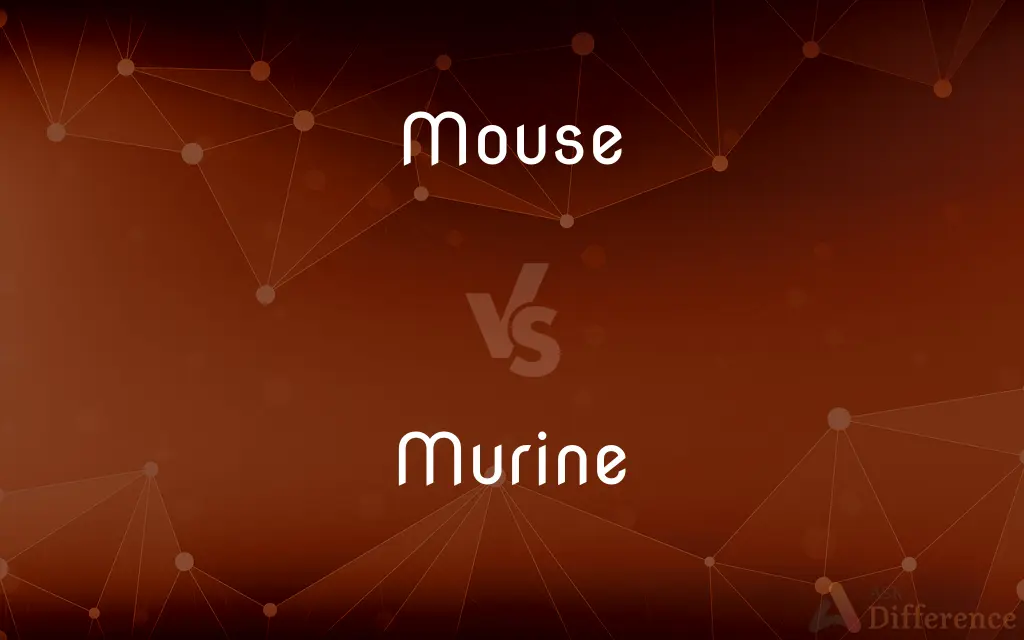Mouse vs. Murine — What's the Difference?
By Fiza Rafique & Maham Liaqat — Updated on February 28, 2024
"Mouse" refers to a small rodent, commonly used in research, while "murine" describes anything related to or resembling mice, including diseases and genetic traits.

Difference Between Mouse and Murine
Table of Contents
ADVERTISEMENT
Key Differences
A mouse is a well-known small rodent, often kept as a pet or used in scientific research due to its size and genetic similarities to humans. Murine, on the other hand, is an adjective that pertains to mice or rats, commonly used in scientific contexts to describe diseases, models, or genetic characteristics that are related to these rodents.
Mice are characterized by their small size, pointed snouts, and long tails, making them distinct in the animal kingdom. The term murine is used to denote characteristics or conditions specifically associated with mice or rats, such as murine leukemia viruses, highlighting its broader applicability beyond just describing the animal.
Mice are utilized for various studies, including genetics, medicine, and behavior, due to their fast reproduction rates and genetic similarities to humans. Murine models or murine diseases refer to the study and investigation of conditions within mice that can offer insights into human diseases, emphasizing the scientific utility of the term.
The care and handling of mice vary significantly depending on their environment (pets, wild, or laboratory settings). In contrast, murine studies or references typically involve controlled laboratory conditions where researchers study disease mechanisms, drug efficacy, and genetic traits.
The term mouse directly refers to the animal, murine expands the context to include anything related to mice, from diseases to genetic studies, underscoring a critical distinction in usage between everyday and scientific language.
ADVERTISEMENT
Comparison Chart
Definition
A small rodent species.
Relating to or resembling mice.
Context
General and scientific.
Primarily scientific.
Usage
Refers to the animal itself.
Describes diseases, models, genetic traits related to mice.
Research Relevance
Subject of scientific studies.
Pertains to studies involving mouse models or diseases.
Examples
Pet mice, laboratory mice.
Murine leukemia viruses, murine models in research.
Compare with Definitions
Mouse
Commonly used in research for its genetic similarities to humans.
Scientists used mice to study the effects of a new drug.
Murine
Refers to anything resembling or related to mice.
Murine features are often observed in certain genetic mutations.
Mouse
Known for its fast reproduction rate.
Mice populations can increase quickly due to their breeding habits.
Murine
Pertaining to mice or rats, especially in scientific research.
The murine model was used to study cancer development.
Mouse
A small rodent with a pointed snout and long tail.
The laboratory mouse is a key model organism in genetics research.
Murine
Relating to diseases common to mice or used as models for human disease.
Murine leukemia viruses are studied to understand human leukemia.
Mouse
Utilized in a variety of scientific fields.
Behavioral scientists study mice to understand learning processes.
Murine
Involves genetic traits associated with mice.
Researchers identified a murine gene that affects aging.
Mouse
Can be found in wild, domestic, or laboratory settings.
A wild mouse found its way into the house.
Murine
Used in the context of laboratory research.
Murine studies have contributed significantly to immunology.
Mouse
A mouse, plural mice, is a small rodent. Characteristically, mice are known to have a pointed snout, small rounded ears, a body-length scaly tail, and a high breeding rate.
Murine
Of or relating to a rodent of the subfamily Murinae, which includes the house mouse and the brown rat.
Mouse
A small rodent that typically has a pointed snout, relatively large ears and eyes, and a long tail.
Common Curiosities
What is a mouse used for in research?
Mice are used in research to study genetics, diseases, drug responses, and behavioral science due to their similarity to humans and fast reproduction rates.
How are mice important to scientific research?
Mice are important because they offer a closely related genetic model to humans, allowing scientists to study human diseases, genetics, and potential treatments in a controlled environment.
What distinguishes a mouse from murine diseases?
A mouse is the actual animal, while murine diseases refer to conditions studied within mice that may provide insights into human health issues.
How do researchers use murine models?
Researchers use murine models to replicate human disease conditions, test drug efficacy and safety, and study genetic traits and behaviors.
Can the term murine be used to refer to any rodent?
While murine technically pertains to mice and rats, it is most commonly associated with mice in scientific research contexts.
What does murine mean?
Murine means relating to or resembling mice or rats, often used in scientific contexts to describe diseases, genetic models, or traits associated with these rodents.
Why are murine models preferred in research?
Murine models are preferred due to the physiological and genetic similarities to humans, making them invaluable for studying a wide range of human diseases and treatments.
What's the significance of murine genetic studies?
Murine genetic studies are significant because they help identify the genetic basis of diseases, which can lead to the development of targeted therapies and drugs for humans.
What's the difference between murine and human diseases?
Murine diseases are conditions studied within mice, which can mirror or provide insights into human diseases, although there may be differences in disease manifestation and treatment responses.
Can murine research directly translate to human treatments?
While murine research provides crucial insights, direct translation to human treatments requires further testing and validation due to physiological and genetic differences between mice and humans.
Share Your Discovery

Previous Comparison
Harmony vs. Melody
Next Comparison
Sinful vs. WickedAuthor Spotlight
Written by
Fiza RafiqueFiza Rafique is a skilled content writer at AskDifference.com, where she meticulously refines and enhances written pieces. Drawing from her vast editorial expertise, Fiza ensures clarity, accuracy, and precision in every article. Passionate about language, she continually seeks to elevate the quality of content for readers worldwide.
Co-written by
Maham Liaqat













































